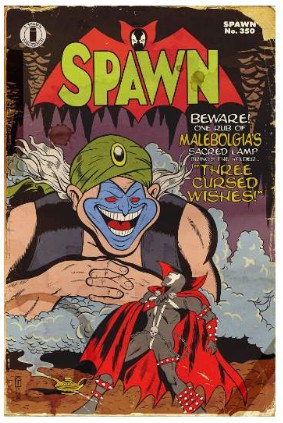By Mike Wheeler

In a bold move to celebrate the iconic comic book character Spawn, Todd McFarlane, the creator of Spawn, announced a unique contest dubbed “Spawnuary” on December 29th, 2023. The contest, which ran throughout the month of January, invited artists from around the world to submit their artwork for a chance to be featured on the cover of various Spawn-related publications. However, what was intended as a celebration of creativity quickly sparked controversy and skepticism among the artistic community.
With McFarlane’s reputation and influence, the contest generated significant buzz, accumulating over 2,500 submissions. It was evident that artists were eager to participate and make their mark. However, just as quickly as submissions flooded in, excitement began to fade, and controversy arose. Frustrations emerged over a lack of payment, transparency, fairness of competition, and concerns that the contest was no more than a publicity stunt.
Fueling skepticism was the requirement for artists to sign up for McFarlane’s newsletter to get the contest submission blue-line digital paper and instructions. This tactic, while expanding McFarlane’s reach, raised questions about whether the contest was primarily a marketing ploy to increase newsletter subscriptions rather than a genuine opportunity for artists.
Another point of contention was the absence of fair compensation for artists’ labor. With no mention of financial compensation or opportunities for ongoing work, participating artists might feel exploited or undervalued, particularly if their contributions are not adequately recognized.
The inclusion of industry veterans in the contest added another layer of complexity. While McFarlane claimed that the contest was open to everyone, regardless of experience, some questioned the fairness of pitting seasoned professionals against aspiring artists. With established names in the industry vying for recognition alongside newcomers, the playing field appeared anything but level.

Doubts arose about whether Todd McFarlane, given his busy schedule and numerous commitments, really had the time or inclination to personally review each submission. Even if he did personally review each one, it seemed improbable he would dedicate the necessary time to thoroughly evaluate every entry.
Furthermore, the lack of clear guidelines or criteria for submissions added to the uncertainty surrounding Spawnuary. Without specific instructions on what McFarlane and his team were looking for, artists were left to speculate and second-guess themselves. This ambiguity made it challenging for artists to tailor their submissions to meet the contest’s undisclosed expectations, not knowing how to make their artwork stand out from the rest. Frustrated artists felt their chances were slim-to-none.
Despite these concerns, the allure of exposure and recognition within the comic book industry remained a powerful draw for aspiring artists. The opportunity to have artwork featured in a high-profile publication like Spawn could open doors to future opportunities and elevate an artist’s profile within the industry.
In the wake of Spawnuary, broader questions arose about the role of contests and competitions in the comic book industry. While contests can be an effective way to engage fans and discover new talent, they must be conducted with transparency and integrity to maintain credibility and trust within the community. Smaller publishers have successfully run contests that engage their fan base and provide opportunities for aspiring artists without overwhelming them with thousands of submissions.
Additionally, this publication reached out to McFarlane and his assistant Bonnie prior to the launch of Spawnuary and were told that an interview would be possible. After getting McFarlane’s acceptance for an interview, the contest launched, and the interview was suddenly passed over without explanation, leaving one to wonder if McFarlane was only interested in press to help bring exposure to the contest and harness more newsletter subscriptions. The refusal of an interview after repeated requests and assurances adds another layer of mystery to the situation and raises questions about McFarlane’s true motivations and commitment to supporting emerging artists.
Ultimately, the true value of Spawnuary may lie not in the recognition or exposure it offers, but in the conversations it sparks about the treatment of artists within the comic book industry. By shining a light on the challenges faced by aspiring artists and the need for fair compensation and recognition, Spawnuary serves as a reminder that artists deserve to be valued for their contributions and not exploited for their talent.
As of February 19, 2024, nearly two months after the conclusion of Spawnuary, the winners of Todd McFarlane’s highly publicized contest are yet to be announced. Some have questioned whether the delay in announcing the winners is indicative of behind-the-scenes conflicts or disagreements among the judges, if there are any. Others have expressed concerns about the integrity of the contest and whether the judging process is being conducted fairly and impartially. Despite these challenges, there are those who remain hopeful that the delay is simply a result of the organizers taking the time to thoroughly review and evaluate each submission. They believe that McFarlane’s commitment to supporting emerging talent will ultimately shine through and that the winners will be chosen based on merit and originality.

Despite the uncertainties surrounding McFarlane’s contest, participating artists may still find some value in the experience. While the likelihood of personal recognition from McFarlane may be slim, the contest provides a platform for artists to showcase their work and potentially gain exposure within their own social circles. Bold and provocative submissions, such as Matthew’s “FUCK YOU PAY ME” cover, have the potential to make a lasting impression and garner attention, even if they don’t ultimately secure victory in the contest.
The legacy of Spawnuary hangs in the balance, with its success or failure ultimately hinging on the integrity and fairness of the contest’s outcome. How McFarlane and his team choose to address the concerns and criticisms surrounding the contest will undoubtedly shape its lasting impact on the industry and its perception within the artistic community.
